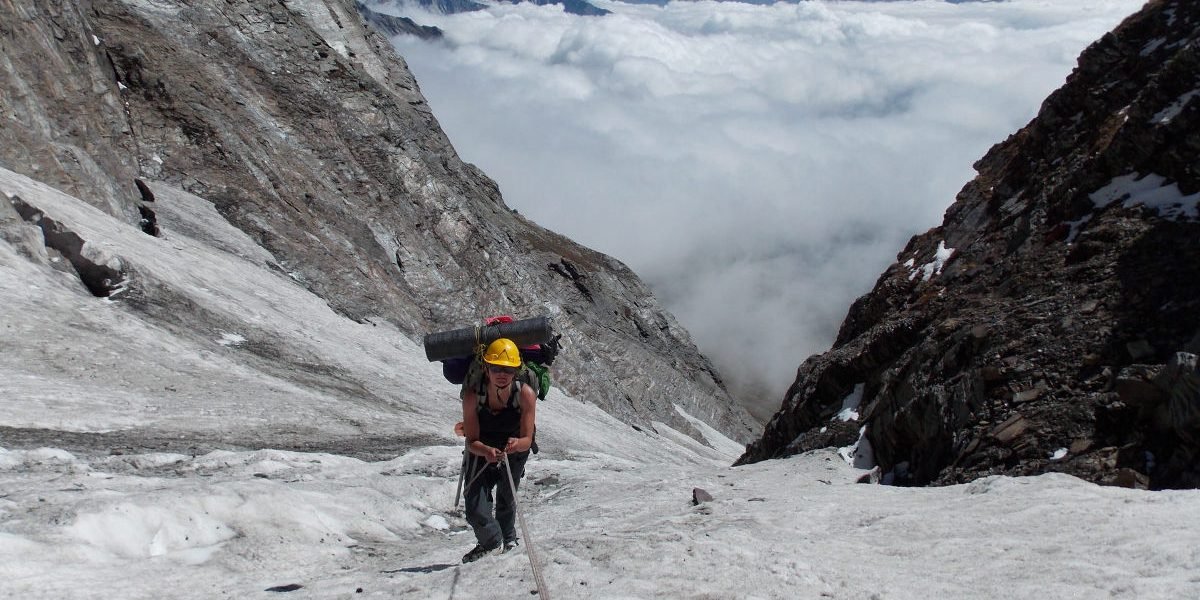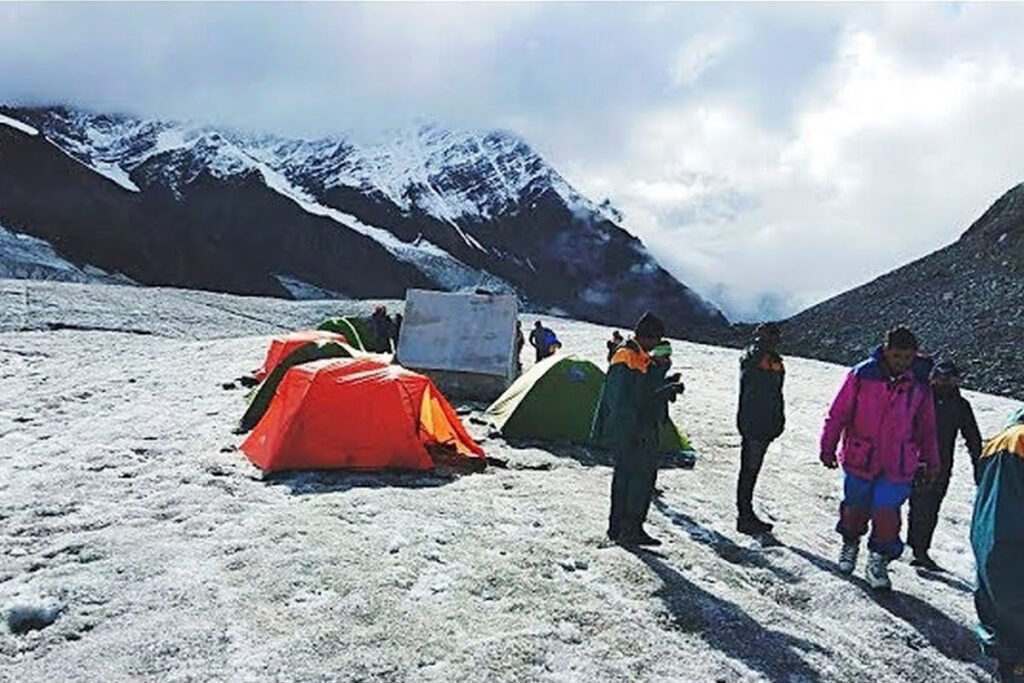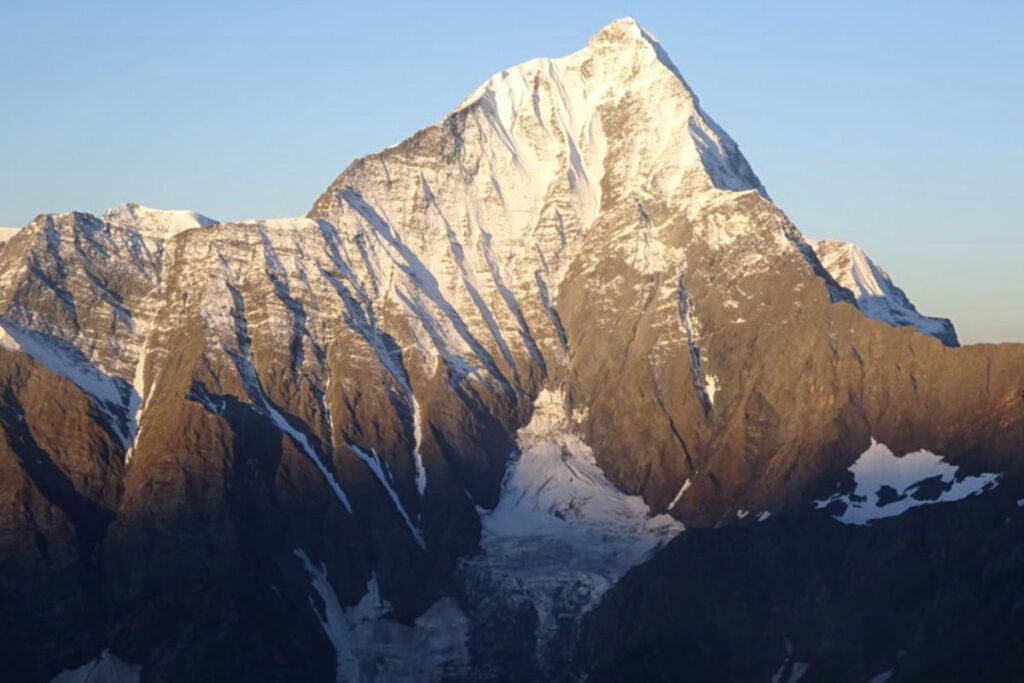
Overview
The Hanuman Tibba Winter Expedition is one of the most soughtafter high-altitude climbing adventures in the western Himalayas, towering proudly at 5,982 meters. For seasoned trekkers and mountaineers, Hanuman Tibba Expedition offers a rare blend of steep terrains, dramatic ice walls and breathtaking panoramic views of Pir Panjal, Bara Shigri and Dhauladhar ranges. When experienced with Adventure Valley, Hanuman Tibba expedition transforms into a meticulously planned and safe climbing journey that pushes limits while ensuring an unforgettable Himalayan experience.
Adventure Valley promises responsible climbing, certified mountaineering guides, premium logistics, acclimatization planning and emergency response preparedness making it the ideal expedition partner for anyone dreaming of summiting Hanuman Tibba Winter Expedition. Winter Hanuman Tibba Expedition is not just an expedition—it’s a spiritual journey, a raw Himalayan experience that stays with you forever. Perfect for skilled mountaineers seeking their next big winter challenge.
Highlights of Hanuman Tibba Expedition
Reach the summit of 5,982 meters, the highest peak of the Dhauladhar Range.
- Trek through scenic valleys, including Solang, Dhundi and Bakarthach.
- Climb across the stunning Beas Kund Glacier with breathtaking ice formations.
- Experience technical mountaineering with ropes, crampons, ice axe, and steep snow slopes.
- Enjoy panoramic 360° views of Pir Panjal, Bara Shigri, Deo Tibba, and Indrasan peaks from the summit.
- Set up alpine camps on the glacier, under a sky full of stars and fresh snowfall.
- Learn essential climbing techniques guided by certified and experienced mountaineers.
- Boost endurance and mental strength, pushing beyond comfort zones in extreme conditions.
- Safe and organized expedition planning, including acclimatization, rescue backup, and nutritious meals.
- Hanuman Tibba Expedition perfect challenge for adventure lovers, offering thrill, achievement and lifelong memories.
Best Time to Visit Hanuman Tibba Expedition
The best time to attempt the Winter Hanuman Tibba Expedition is from late December to early March, when the mountain is fully covered in deep, stable snow and the true winter challenge unfolds. These months offer the most authentic alpine experience icy slopes, frozen landscapes and crisp, clear skies that provide excellent visibility for highaltitude climbing.
January and February are considered the peak winter months, ideal for experienced mountaineers seeking technical routes and real winter conditions. During this period, temperatures can drop to –15°C to –25°C, especially at higher camps, making it essential for climbers to be physically and mentally prepared.
How to Reach Hanuman Tibba Expedition
Reaching the starting point of the Winter Hanuman Tibba Winter Expedition is easy and well-connected through major routes. The Hanuman Tibba Winter Expedition generally begins from Manali, followed by a drive to Dhundhi or Solang Valley, depending on the weather and trail conditions.
By Air: The nearest airport is Kullu–Manali Airport (Bhuntar), located about 50 km from Manali. Regular flights are available from Delhi and Chandigarh. From the airport, you can hire a taxi or take a bus to Manali.
By Road: Manali is well-connected via road from major North Indian cities.
- Delhi to Manali: 540 km (12–14 hours)
- Chandigarh to Manali: 290 km (7–8 hours)
- Volvo buses and private taxis operate daily.
By Train: The nearest major railway stations are Joginder Nagar (163 km) and Chandigarh (290 km). From there, taxis and buses are available to Manali.
From Manali to Base Point
After reaching Manali, a short drive takes you to Solang Valley/Dhundhi, followed by the trek toward Bakarthach and Beas Kund Glacier, leading eventually to the Hanuman Tibba Winter Expedition route.
How to Reach Hanuman Tibba Expedition
Winter on Hanuman Tibba Expedition is extreme, raw and unpredictable making the Hanuman Tibba Winter Expedition a true test of endurance and skill. From late December to early March, the entire region remains blanketed in deep snow, with temperatures dropping drastically both during the day and night. At the base camp and higher camps, temperatures typically range between –10°C to –25°C, and during summit attempts, the wind chill can make it feel even colder.
Strong winds, sudden snowstorms and whiteout conditions are common at high altitudes, demanding proper gear, experience and expert guidance. The slopes remain icy and hard-packed, requiring technical equipment like crampons, ice axes and fixed ropes for safe climbing.
Despite the harshness, winter also brings clear blue skies, breathtaking sunrise views and excellent visibility on many days offering stunning panoramas of the Pir Panjal, Dhauladhar and surrounding Himalayan peaks. Winter conditions are tough but truly rewarding for seasoned
mountaineers.
Hanuman Tibba Expedition – Day Wise Itinerary
Day 1: Arrive in Manali
Day 2: Manali to Dhundi to Bakkarthatch
Day 3: Bakkarthatch to Beas Kund Glacier
Day 4: Rest and acclimatization
Day 5: Base Camp to Advance Camp and back to Base Camp
Day 6: Base Camp to Advance Camp
Day 7: Advance Camp to Camp 1
Day 8: Camp 1 to Summit Camp
Day 9: Summit attempt and back to Camp 1
Day 10: Camp 1 to Base Camp
Day 11: Rest at Base Camp
Day 12: Base Camp to Manali
Day 13: Buffer Day
Hanuman Tibba Expedition - Things to Carry
1. Clothing & Layering
- Thermal inner layers (top & bottom)
- Fleece jacket / mid-layers
- Heavy down jacket (–20°C rated)
- Waterproof & windproof outer shell (jacket + pants)
- Multiple pairs of woolen socks
- Insulated gloves + waterproof outer gloves
- Balaclava, neck gaiter & thermal cap
- UV-protection sunglasses / glacier goggles
2. Footwear
- High-ankle waterproof trekking boots
- Insulated mountaineering boots (for summit day)
- Gaiters for deep snow
- Extra pair of trekking socks
3. Documents
- Govt. ID
- Medical fitness certificate
- Expedition permits (handled by team)
4. Technical Gear (usually provided by the expedition team)
- Crampons
- Ice axe
- Harness & carabiners
- Helmet
- Ascender/descender
- Snow boots (if not carrying your own)
- Rope (guided teams manage this)
5. Camping & Sleeping Essentials
- Sub-zero sleeping bag (–15°C to –20°C)
- Insulated sleeping mat
- Headlamp with extra batteries
6. Personal Items
- Water bottles (insulated) / hydration system
- High-energy snacks (nuts, chocolates, protein bars)
- Personal medication kit
- Sunscreen (50+ SPF) & lip balm
- Toiletries & biodegradable wet wipes
- Power bank &Trekking pole(s)
Hanuman Tibba Expedition - Important Tips for Climbers
Winter climbs on Hanuman Tibba Expedition demand serious preparation, strong fitness and technical awareness
1. Build Strong Physical Fitness
Begin training at least 6–8 weeks before the Hanuman Tibba Winter Expedition. Focus on endurance, leg strength, cardio and carrying a backpack during practice hikes. Winter climbs involve deep snow, steep ascents and long hours of movement.
2. Master Basic Mountaineering Techniques
Learn essential skills like using crampons, ice-axe self-arrest, rope management and walking on icy slopes. These are critical for safety on technical patches.
3. Acclimatize Properly
Spend time adjusting to the altitude in Manali. Follow the team’s acclimatization schedule strictly to avoid AMS.
4. Carry the Right Gear
High-quality winter gear is non-negotiable. Make sure your boots, gloves and outer shell are suitable for –20°C to –25°C conditions.
5. Stay Hydrated & Eat Well
Cold weather reduces thirst, but your body needs more water and calories at high altitude. Drink regularly and consume high-energy snacks.
6. Follow Safety Instructions
Listen to your guides at all times especially during rope sections, crevasse zones and summit push. Safety protocols save lives in winter.
7. Prepare Mentally for Harsh Conditions
Expect strong winds, freezing temperatures, slow movement and challenging terrain. Mental resilience is as important as physical strength.
8. Move Slowly & Steady
Avoid rushing. Maintain a consistent pace to conserve energy and avoid exhaustion in freezing temperatures.
9. Protect Your Skin & Eyes
Use high SPF sunscreen, lip balm and glacier goggles. Snow glare and harsh winds can cause burns and snow blindness.
10. Respect the Mountain & Weather
Winter weather is unpredictable. Be flexible summit attempts may shift depending on safety and conditions.
Why Choose Winter Hanuman Tibba Expedition
The Winter Hanuman Tibba Expedition with Adventure Valley means experiencing the Himalayas in their most raw, challenging, and rewarding forms. Winter adds a fresh layer of snow, extreme temperatures and stronger winds, transforming Hanuman Tibba Expedition into a true test of skill and endurance perfect for climbers seeking real highaltitude adventure.
During winter, the mountain trails are less crowded, allowing pure solitude amid untouched snowy landscapes, frozen glaciers and crystal-clear mountain skies. Adventure Valley enhances Winter Hanuman Tibba Expedition with unmatched safety and professional planning. Adventure Valley team consists of UIAA and NIM-certified mountaineers who have deep experience climbing Hanuman Tibba Expedition in every season.
Their precise route knowledge, risk assessment and emergency preparedness greatly increase the safety and success rate of the summit attempt. Winter-grade tents, premium climbing gear and high-calorie alpine meals ensure warmth, comfort and physical strength during the harshest conditions. The itinerary also includes proper acclimatization and technical training, making climbers efficient on ice and steep snow slopes.
For adventure lovers who want to challenge their limits, build mountaineering skill, and witness the Himalayas in their most dramatic season, the Winter Hanuman Tibba Expedition with
Adventure Valley offers an unforgettable and empowering achievement.
Who Should Avoid the Winter Hanuman Tibba Expedition
1. Beginners with No Trekking or Mountaineering Experience
2. People with Medical Conditions
3. Individuals Not Comfortable in Extreme Cold
4. Low Fitness or Endurance Levels
5. Those Unprepared for Technical Climbing
6. People Afraid of Heights or Exposure
7. Climbers Who Cannot Handle Long, Tough Summit Nights
8. Individuals Without Mental Resilience
9. Anyone Expecting a Leisure Trek
FAQ Of Hanuman Tibba Winter Expedition
Qns. Is the Winter Hanuman Tibba Expedition suitable for beginners?
Ans : No. The winter climb is highly technical and physically demanding. Only trained and experienced mountaineers should attempt it.
Qns. What is the best time to attempt the Winter Hanuman Tibba Expedition?
Ans : The ideal winter climbing window is from late December to early March, when snow conditions are stable and the weather is clearer.
Qns. How difficult is the climb during Winter Hanuman Tibba Expedition?
Ans : Winter conditions add deep snow, icy slopes, harsh temperatures and high winds, making the climb Difficult or Technical. Proper training is mandatory.
Qns. What is the maximum altitude reached Winter Hanuman Tibba Expedition?
Ans : The summit height is 5,982 meters, making it one of the highest peaks accessible from the Manali region.
Qns. Do I need mountaineering training for Winter Hanuman Tibba Expedition?
Ans : Yes. Climbers must be familiar with:
- Ice-axe techniques
- Crampon walking
- Rope fixing
- Glacier navigation
- Crevasse rescue basics
Qns. What kind of weather should I expect Winter Hanuman Tibba Expedition?
Ans : Expect Winter Hanuman Tibba Expedition conditions:
- Day temperature: –5°C to –10°C
- Night temperature: –12°C to –20°C
- Heavy winds and occasional snowstorms
Qns. What gear is required for the winter Hanuman Tibba Expedition climb?
Ans : Essential gear includes:
- Ice axe, crampons, climbing harness
- Down jacket, snow gloves, thermal layers
- High-altitude boots
- Helmet, ropes, gaiters
Your operator usually provides technical gear.
Qns. Is the Winter Hanuman Tibba Expedition route risky due to crevasses?
Ans : Yes. The Beas Kund Glacier has crevasse zones. Climbers must always remain roped and follow the guide’s instructions.
Qns. How long does the Winter Hanuman Tibba Expedition take?
Ans : The winter expedition typically takes 10-11 days, including acclimatization.
Qns. Are meals provided during the Winter Hanuman Tibba Expedition?
Ans : Yes. Climbers are served hot meals like soups, highcalorie dishes, dal-rice, chapati, oats, tea, and warm water.
Qns. Is there any age limit for the Winter Hanuman Tibba Expedition?
Ans : Adventure Valley operators allow climbers between 18–55 years with medical fitness.
Qns. How many guides accompany the team Winter Hanuman Tibba Expedition?
Ans : Professional expeditions usually include:
- 1 Lead Climbing Guide
- 1–2 Technical Instructors
- Support team including porters and cooks
Qns. What is the nearest town to start the Winter Hanuman Tibba Expedition?
Ans : Manali is the nearest major town. The Winter Hanuman Tibba Expedition begins from Solang Valley 13–14 km away.
Conclusion
The Winter Hanuman Tibba Expedition is not just a climb it is a test of endurance, technique and mental resilience. The frozen glaciers, silent valleys and snow-covered slopes create a surreal world where every step is a victory. Conquering Hanuman Tibba Expedition in winter is a rare achievement, offering memories and lessons that stay forever.
Location
Social Media
Google Review
Trustindex verifies that the original source of the review is Google. This camping beyond the beautiful words.honest staff and friendly owner and beautiful loction good vibes.Posted onTrustindex verifies that the original source of the review is Google. It's amazing. Love the way they treat.Posted onTrustindex verifies that the original source of the review is Google. Best place to stay and the best views and the service is awesome neat and clean Roshan bhai and Jony bhai are like family membersPosted onTrustindex verifies that the original source of the review is Google. Perfect location , very good tent and place cleanliness also the staff is good and polite And the location is just so so so peaceful , calm and soothingPosted onTrustindex verifies that the original source of the review is Google. Very poor service.Incompetent staff.Rude behaviour by owner.Pale dirty drinking water.Very unhygienic toilets.No basic amities in rooms. Poor food.Worst experience.Posted onTrustindex verifies that the original source of the review is Google. Great location. great experience in tent stay with good food

